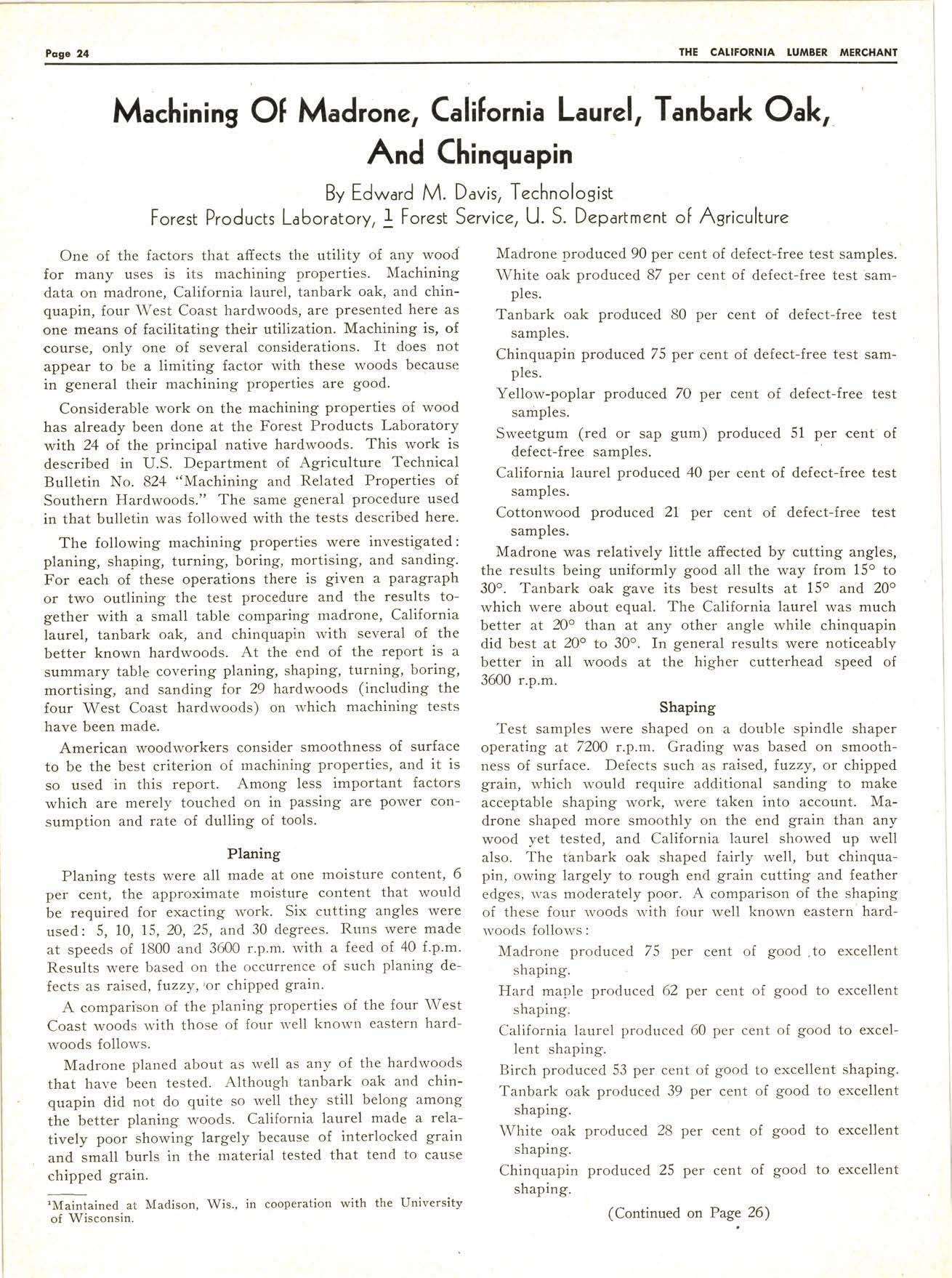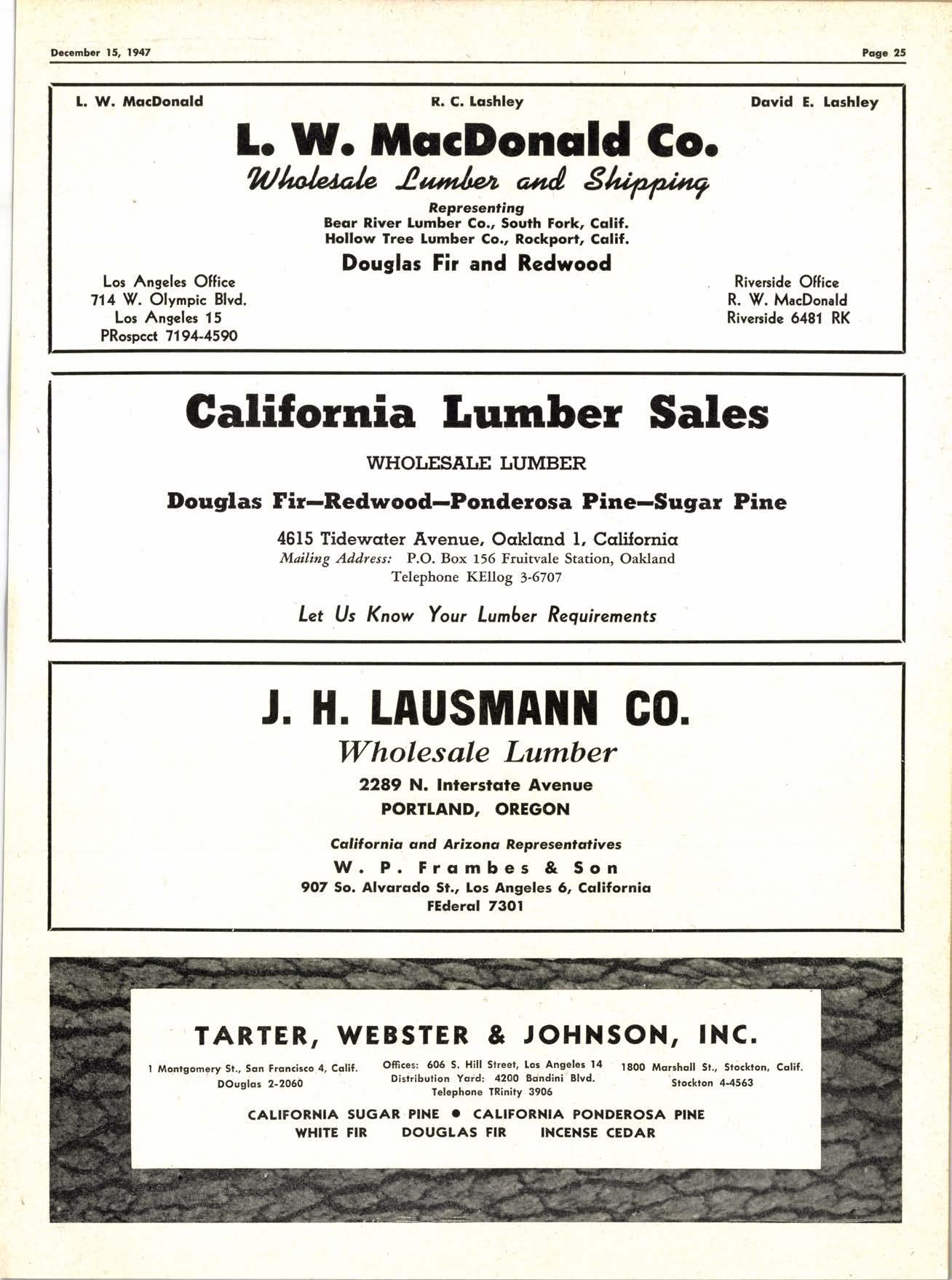
5 minute read
Machining Of Madrone, Calilornia Laurel, TanbarkOalc,
And Chinquapin
By Edward M. Davis, Technologist
Forest Products Laboratory, ] Fore* Service, U. S. Department of Agriculture
One of the facto{s that affects the utility of any wood for many uses is its machining oroperties. Machining data on madrone, California laurel, tanbark oak, and chinquapin, four West Coast hardwoods, are presented here as one means of facilitating their utilization. Machining is, of course, only one of several considerations. It does not appear to be a limiting factor with these woods because in general their machining properties are good'
Considerable work on the machining properties of wood has already been done at the Forest Products Laboratory with 24 of the principal native hardwoods. This work is described in U.S. Department of Agriculture Technical Bulletin No. 824 "Machining and Related Properties of Southern Hardwoods." The same general procedure used in that bulletin was followed with the tests described here.
The following machining properties were investigated: planing, shaping, turning, boring, mortising, and sanding. For each of these operations there is given a paragraph or two outlining the test procedure and the results together with a small table comparing madrone, California laurel, tanbark oak, and chinquapin with several of the better known hardwoods. At the end of the report is a summary table covering planing, shaping, turning, boring, mortising, and sanding for 29 hardwoods (including the four West Coast hardwoods) on which machining tests have been made.
American woodworkers consider smoothness of surface to be the best criterion of machining properties, and it is so used in this report. Among less important factors which are merely touched on in passing are power consumption and rate of dulling of tools.
Planing
Planing tests were all made at one moisture content, 6 per cent, the approximate moisture content that would be required for exacting work. Six cutting angles were used: 5, 10, 15, n, 25, and 30 degrees. Runs were made at speeds of 1800 and 3600 r.p.m. 'ivith a feed of 40 f.p.m. Results were based on the occurrence of such planing defects as raised, luzzy, 'or chipped grain'
A comparison of the planing properties of the four West Coast woods with those of four well known eastern hardwoods follows.
Madrone planed about as well as any of the hardwoods that have been tested. Although tanbark oak and chinquapin did not do quite so well they still belong among the better planing woods. California laurel made a relatively poor showing largely because of interlocked grain and small burls in the material tested that tend to cause chipped grain.
Madrone produced 90 per cent of defect-free test samples. White oak produced 87 per cent of defect-free test samples.
Tanbark oak produced 80 per cent of defect-free test samples.
Chinquapin produced 75 per cent of defect-free test samples.
Yellow-poplar produced 70 per cent of defect-free test samples.
Sweetgum (red or sap gum) produced 51 per cent'of defect-free samples.
California laurel produced 40 per cent of defect-free test samples.
Cottonwood produced 2l per cent of defect-free test samples.
Madrone was relatively little affected by cutting angles, the results being uniformly good all the way from 15" to 30o. Tanbark oak gave its best results at 1.5o and 20o which were about equal. The California laurei was much better at ho than at any other angle while chinquapin did best at 20o to 30o. In general results were noticeably better in all woods at the higher cutterhead speed of 3600 r.p.m.
Shaping
Test samples were shaped on a double spindle shaper operating at 72ffi r.p.m. Grading was based on smoothness of surface. Defects such as raised, luzzy, or chipped grain, which would require additional sanding to make acceptable shaping work, were taken into account. Madrone shaped more smoothly on the end grain than any wood yet tested, and California laurel showed up well also. The thnbark oak shaped fairly well, but chinquapin, owing largely to rough end grain cutting and feather edges, was moderately poor. A comparison of the shaping of these four woods with four well known eastern'hardr.voods follows :
Madrone produced 75 per cent of good .to excellent shaping.
Hard maple produced 62 per cent of good to excellent shaping.
California laurel produced 60 per cent lent shaping.
Birch produced 53 per cent of good to Tanbark oak produced 39 per cent of shaping.
White oak produced. 28 per cent of shaping.
Chinquapin produced 25 per cent of shaping.
(Continued on Page 26) of good to excelexcellent shaping. good to excellent good to excellent good to excellent

Machining of Madrone, California Laurel, Tanbark Oak, and Chinquapin
(Continued from Page 24)
Sweetgum (red or sap gum) produced 2l per cent of : *ood to excellent shaping.
Turning
Turnings were cut by means of a milled-to-pattern knife which insured uniformity of size and shape. The pattern contained the head, the cove, and cuts at different angles to the grain. Turnings wdre than carelully graded with special reference to sharpness of detail and smoothness of cut. Madrone and California laurel both turned very well requiring a minimum of subsequent sanding. Tanbark oak and chinquapin may be considered fair turning woods. The latter often showed a tendency toward minute rough;ness. These woods compared with three well known eastern hardwoods as shown below:
Black walnut produced 91 per cent of good to excellent turnings.
Madrone produced 88 per cent of good to excellent turnings.
California laurel produced 86 per cent of good to excellent turnings.
Tanbark oak produced 81 per cent of good to excellent turnings.
Birch produced 80 per cent of good to excellent turnings.
Chinquapin produced 77 per cent of good to excellent turnings.
Cottonwood produced 7O per cent of good to excellent turnings.
Boring
A series of l-inch holes was bored using a standard type wood bit driven at 2400 r.p.m. in a small boring machine. The holes were examined and graded for smoothness of cut, then measured by means of a plug gage for trueness to size. The madrone, California laurel, and tanbark oak were equal to any woods tested for smoothness of cut, and the chinquapin was good. But when it comes to trueness to size, the chinquapin and California laurel were no better than fair, while the, madrone and tanbark oak were among the more variable woods. For most uses, however, smoothness of cut is the more important consideration and the comparison which follows is based on smoothness of cut onlv: per cent of to excellent

Black walnut produced 100 per cent of good to excellent samples.
Madrone produced 100 per cent of good to excellent samples.
California laurel produced 100 per cent of good to excellent samples.
Tanbark oak produced 100 per cent of good to excellent samples.
White oak produced 95 per aent of , good to excellent samples.
Sweetgum (red or sap gum) produced 92 good to excellent samples.
Chinquapin produced 9O per cent of good samples.
Cottonwood produced 70 per cent of good to excellent samples.
Mortising
A series of half inch square mortises was cut using a standard type hollow chisel mortiser. The finished mortises were examined and graded for smoothness of cut, and measured with a steel gage for trueness to size' The California laurel and tanbark oak mortised as smoothly as any of the woods that have been tested. Madrone and chinquapin, although not quite so good, belong among the better woods in this respect. The chinquapin and tanbark oak rate good in trueness to size of mortises, while the California laurel and madrone rate fair. The following comparison is based on smoothness of cut only:
White oak produced 100 per cent of fair to excellent mortises.
Tanbark oak produced 100 per cent of fair to excellent mortises.
California laurel produced 100 per cent of fair to excellent mortises.
Hard maple produce 95 per cent of fair to excellent mortises.
Madrone produced 95 per cent of fair to excellent mortises.
Chinquapin produ'ced 90 per cent of fair to excellent mortises.
Yellow-poplar produced 63 per cent of fair to excellent mortises.
Cottonwood produced 52 per cent of fair to excellent mortises.
(Continued on Page 28)










